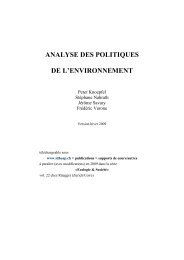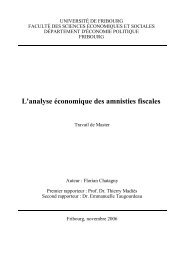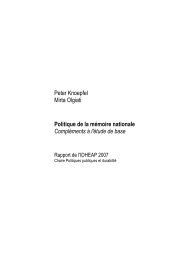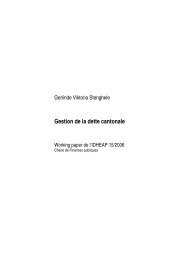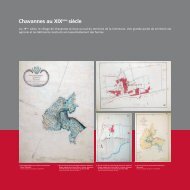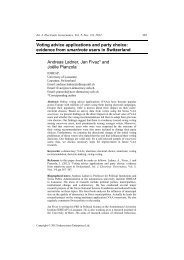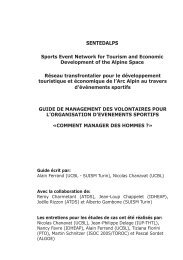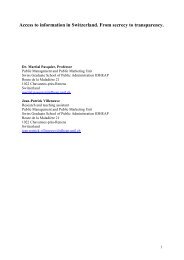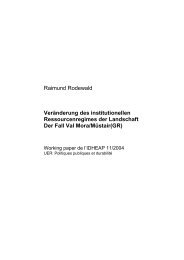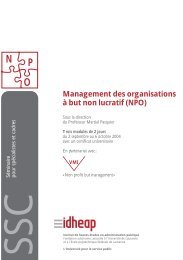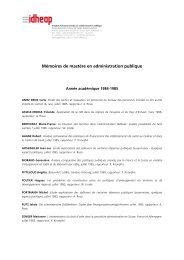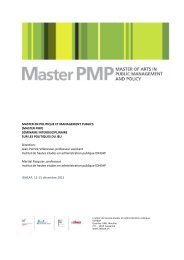Historical Analysis of Institutional Regimes in Switzerland ... - IDHEAP
Historical Analysis of Institutional Regimes in Switzerland ... - IDHEAP
Historical Analysis of Institutional Regimes in Switzerland ... - IDHEAP
You also want an ePaper? Increase the reach of your titles
YUMPU automatically turns print PDFs into web optimized ePapers that Google loves.
5<br />
self-govern<strong>in</strong>g rules backed up by the state to an <strong>in</strong>effective common-property regime comb<strong>in</strong>ed with<br />
a successful public policy.<br />
• Actual use regimes are the result <strong>of</strong> <strong>in</strong>teraction between the ownership structure, state<br />
<strong>in</strong>tervention and management practice.<br />
Empirical examples demonstrate that the actual use regime is not only dictated by the selected<br />
ownership structure but results from the comb<strong>in</strong>ed <strong>in</strong>teraction <strong>of</strong> the ownership structure, state<br />
<strong>in</strong>tervention and management practice (Kissl<strong>in</strong>g 2000). Thus, constancy <strong>of</strong> structures is not a reliable<br />
<strong>in</strong>dicator <strong>of</strong> the actual management status. Structures can be stable while changes take place <strong>in</strong> the<br />
wider external environment, result<strong>in</strong>g <strong>in</strong> a shift <strong>in</strong> the motivation <strong>of</strong> the resource users as is the case,<br />
for example, <strong>in</strong> extensive areas <strong>of</strong> the Swiss Alps.<br />
The above considerations necessitate the development <strong>of</strong> a wider concept <strong>of</strong> the IR which will:<br />
(1) add the steer<strong>in</strong>g dimension to regime analysis; (2) take <strong>in</strong>to account the <strong>in</strong>fluence <strong>of</strong> use<br />
and protection policies, as well as the emergence and transformation <strong>of</strong> the relevant policy<br />
design; (3) <strong>in</strong>corporate the demands <strong>of</strong> heterogeneous user groups; (4) consider the <strong>in</strong>fluence<br />
<strong>of</strong> management practice as a consequence <strong>of</strong> <strong>in</strong>dividual rationality and changed external<br />
environment.<br />
3.2 Protection and use policies<br />
Classical policy analysis has ma<strong>in</strong>ly focused on the implementation <strong>of</strong> state measures (e.g. protection<br />
and use policies) and on the evaluation <strong>of</strong> the result<strong>in</strong>g effects (e.g. on susta<strong>in</strong>ability <strong>of</strong> natural<br />
resource). In contrast to these empirical studies, little research has been done <strong>in</strong> the area concern<strong>in</strong>g<br />
the actual programme to be implemented (or policy design). No coherent and empirically founded<br />
theory has hitherto been developed to expla<strong>in</strong> why a particular aim, <strong>in</strong>strument or <strong>in</strong>stitutional<br />
arrangement was selected under a specific policy (L<strong>in</strong>der/Peters 1989; Varone/Landry 1997).<br />
Hence, policy design has enriched and transcended public policy analysis.<br />
a) Design <strong>of</strong> protection and use policies<br />
Here, we understand policy design to be all formal legal regulations, <strong>in</strong>formal co-ord<strong>in</strong>ation clauses<br />
and <strong>in</strong>stitutional structures <strong>of</strong> a public (protection or use) policy, which policy makers (parliaments,<br />
governments) and social actors (compet<strong>in</strong>g user groups) deem necessary to regulate the use <strong>of</strong> a<br />
natural resource which is politically perceived as be<strong>in</strong>g scarce. A policy design always <strong>in</strong>cludes<br />
substantial and procedural, material and symbolic dimensions. Here, we suggest that a dist<strong>in</strong>ction be<br />
made between the five constitutive elements def<strong>in</strong>ed below (Knoepfel et al. 1997a: 83ff;<br />
Schneider/Ingram 1997: 81ff).<br />
1. Aims <strong>in</strong>clude the social condition to be aimed at <strong>in</strong> the area <strong>of</strong> the collective problem to be<br />
resolved (e.g. susta<strong>in</strong>able use <strong>of</strong> resources). On the level <strong>of</strong> legislation, such aims are <strong>of</strong>ten<br />
formulated <strong>in</strong> very abstract terms (e.g. "sufficient" biodiversity <strong>in</strong> the landscape).<br />
2. Instruments comprise the measures to be implemented to achieve the def<strong>in</strong>ed aims and the<br />
procedural rules for their implementation. They def<strong>in</strong>e the <strong>in</strong>tensity <strong>of</strong> <strong>in</strong>tervention <strong>in</strong>volved <strong>in</strong><br />
a policy design (e.g. <strong>in</strong>formation campaign, f<strong>in</strong>ancial <strong>in</strong>centives, rules/bans) and the<br />
procedural form to be taken by the exchange between the relevant adm<strong>in</strong>istrative authorities<br />
and resource user groups (e.g. obligatory consultation, legal right <strong>of</strong> appeal).



